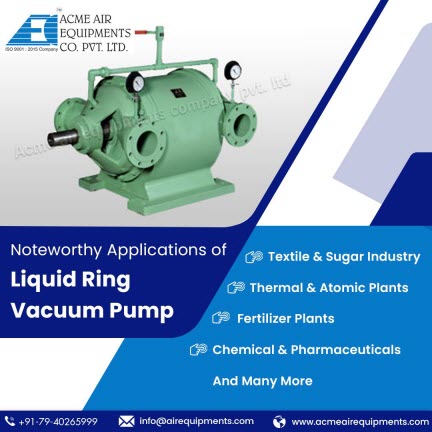Introduction
Liquid ring vacuum pumps are essential in various industrial applications, providing reliable and efficient vacuum processes. These pumps are used across numerous industries, including chemical, electrical power, environmental, food and beverage processing, marine, mining, oil and gas, pharmaceutical, pulp and paper, and textiles. Utilizing water or other compatible liquids as sealants, liquid ring vacuum pumps offer a safe and robust solution for handling dirty and potentially hazardous gas streams.
How Liquid Ring Vacuum Pumps Work
Principle of Operation
Liquid ring vacuum pumps operate using a simple yet effective mechanism. As the impeller spins within the pump body, the seal liquid forms a ring inside. This creates small chambers that trap gas. The rotor’s axis is eccentric to the body, allowing the liquid to nearly fill and then nearly empty each rotor chamber during a single revolution. This process compresses the gas, facilitating the pumping action. The vacuum inlet and atmospheric discharge ports manage the flow paths for the gas mixture being handled.
During operation, the heat of gas compression dissipates into the seal liquid, with some of the liquid flowing out to discharge. The exhaust gas and residual water discharge are separated, with the gas directed to the house exhaust and the water returned to the pump. A constant flow of cooler seal fluid replaces the used seal fluid, ensuring efficient operation.
Characteristics of Liquid Ring Vacuum Pumps
- Accepts Carryover Liquid ring vacuum pumps can handle impurities such as soft solids, moisture, slugs, and chemicals without damage. These impurities are simply washed out through the pump discharge.
- Cool and Quiet Operation The circulation of sealing water inside the pump keeps it running cool. Additionally, the operation is relatively quiet, typically not exceeding 85 dBA.
- Constant Operation for Any Vacuum Level These pumps can operate continuously at any vacuum level, from 29 in. Hg to atmospheric pressure, ensuring versatility and reliability.
- Easy Maintenance and Longer Pump Life The robust construction of liquid ring vacuum pumps includes only one moving part, the rotor, which is mounted on a shaft supported by long-lasting bearings. This design results in less wear and simpler, more affordable maintenance.
- Environmental Benefits Liquid ring vacuum pumps do not require oil changes, filters, oil-pans, or condensers. This means plant rooms remain clean, free from oil contamination and oil discharges to sewers.
Applications of Liquid Ring Vacuum Pumps
Liquid ring vacuum pumps are versatile and find applications in various industries:
- Chemical Industry: Handling hazardous and corrosive gases safely.
- Electrical Power: Assisting in power generation processes.
- Environmental Engineering: Aiding in pollution control and waste management.
- Food & Beverage Processing: Ensuring hygienic and efficient processing.
- Marine Industry: Providing reliable vacuum for ship operations.
- Mining: Facilitating ore processing and extraction.
- Oil & Gas: Supporting drilling and extraction activities.
- Pharmaceuticals: Ensuring sterile and efficient production environments.
- Pulp & Paper: Enhancing the paper production process.
- Textiles: Assisting in dyeing and finishing processes.

Conclusion
Liquid ring vacuum pumps are a reliable and efficient solution for a wide range of industrial applications. Their ability to handle impurities, cool and quiet operation, constant performance at any vacuum level, easy maintenance, and environmental benefits make them an ideal choice for demanding environments. Understanding their operation and characteristics can help industries leverage these pumps for optimal performance and longevity.
FAQs About Liquid Ring Vacuum Pumps
Liquid ring vacuum pumps are used in various industrial applications, including chemical processing, power generation, environmental engineering, food and beverage processing, marine operations, mining, oil and gas extraction, pharmaceuticals, pulp and paper production, and textiles.
These pumps operate by using a seal liquid to form a ring inside the pump body as the impeller spins. This creates chambers that trap and compress gas, facilitating the pumping action. The heat of compression is dissipated into the seal liquid, which is continuously replaced by cooler fluid.
Benefits include the ability to handle impurities without damage, cool and quiet operation, continuous performance at any vacuum level, easy maintenance, longer pump life, and environmental advantages such as no oil contamination.
Yes, they do not require oil changes, filters, oil-pans, or condensers, which means there is no risk of oil contamination or discharge to sewers, making them an environmentally friendly choice.
Due to their robust construction and having only one moving part (the rotor), liquid ring vacuum pumps require minimal maintenance. The maintenance schedule will depend on the specific application and operating conditions.
Yes, they are designed to safely handle dirty and potentially hazardous gas streams, making them suitable for applications in the chemical and oil and gas industries.
While water is the most common sealant, other process-compatible liquids can also be used depending on the specific application requirements.



